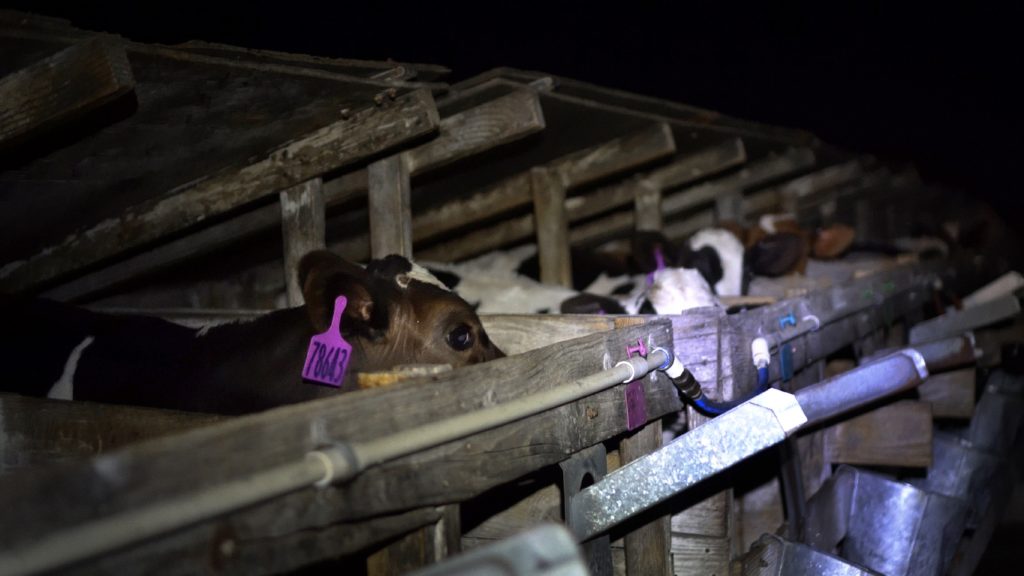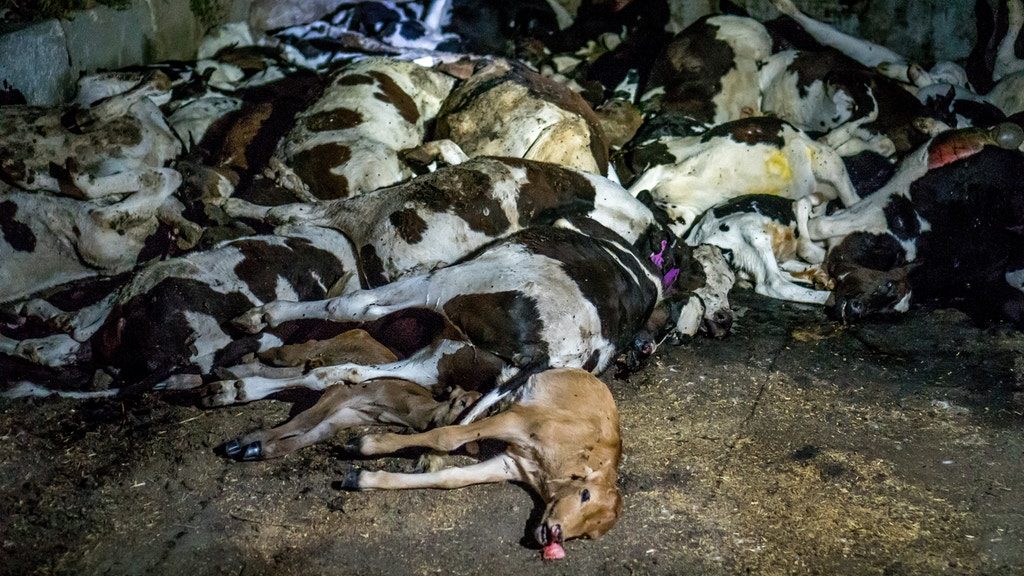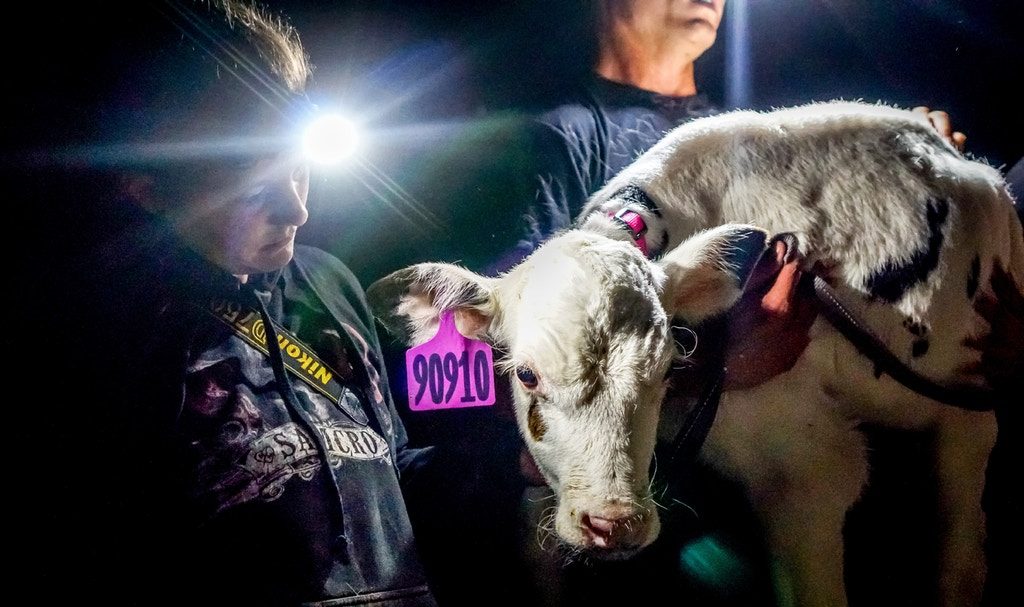Calves in Confinement: Gruesome Footage of Dairy Calves Exposes a Gaping Loophole in California’s Landmark Animal Welfare Law
ANIMAL RIGHTS - VEGETARIANISM, 15 Oct 2018
This article includes graphic images that some readers may find disturbing.
8 Oct 2018 – On a chilly night in December 2016, Julianne Perry led a group of volunteers over the shoulder of the highway and into the darkness of California’s Central Valley, toward the sound of lowing cattle. Their headlamps lit the way across dirt fields, their nostrils and throats filling with the choking smell of ammonia and feces floating in the humid air. They walked toward the sound, as one volunteer described it later, of thousands of cattle screaming. After a mile, they came to their target: a complex of low, wooden buildings that seemed to go on forever in all directions.
Before embarking on their nighttime mission, Perry and the other animal rights volunteers had looked at the area on Google Maps and been staggered by the scale of operations. Google’s satellite imagery showed a vast complex with beef-feeding and calf-raising; a dairy sprawled next door. A count based on the satellite images revealed roughly 4,000 hutches, each with three individual stalls of about 6 1/2 feet by 2 feet, a little larger than a bathtub. That would be space for over 10,000 animals in the vast spread of hutches an eighth of a mile across, beside a lake of feces.
That night, on a portion of the property, they found thousands of black-and-white Holsteins and Jersey calves – breeds commonly used for dairy production – crammed into stalls so small that, as shown by the video they shot, a calf had to turn itself nearly double as it strained to turn around in its stall. Other videos show calves covered in their own filth; the hutches have slats in the floor to let manure fall through into a gutter that was regularly hosed out, but invariably some gets trapped on the floor. “Every time they had to lie down, they had to lie in their own waste,” Perry recalled. “They pee, poop, eat, sleep in one small space.” Aside from clinging to the fur of the cattle, the feces caked on the floor, where it was kicked into aerosol by the nervous shuffling of thousands of calves. “You can’t compare the smell to anything,” Perry said. “It fills your senses in a way that you can’t think of anything but how sick you feel, your brain telling you that you can’t survive here.”
Perry and her fellow volunteers were investigators with Direct Action Everywhere, or DxE, a decentralized group of activists that seeks to publicize the day-to-day doings of industrial agriculture. They had come to this property — 100 miles east of San Francisco — as part of a mission to figure out whether major legal reforms that California had passed in 2008 had made any difference in the lives of calves raised in the state. They found a gaping hole.
Costco’s Hidden Graveyard – Video: Direct Action Everywhere
httpv://www.youtube.com/watch?v=aa1wGZ400MY
In 2008, Californians passed one of the country’s farthest-reaching initiatives to improve farm animal welfare: the Standards for Confining Farm Animals, pushed by a coalition of groups including the Humane Society of the United States. Proposition 2, as it was known, was backed by a number of other animal rights organizations and sought to end what advocates see as one of the worst practices of industrial agriculture: the extreme confinement of some farm animals for their entire lives. Certain classes of animals are packed into excruciatingly tight quarters from birth to slaughter, unable to perform “natural behaviors” like stretching their limbs, kicking their legs, or even turning around in their enclosures.
The statute, billed at the time as one of the most sweeping pieces of animal welfare legislation in American history, targeted what advocates saw as the worst categories: egg-laying hens, crammed together in battery cages; mother sows, confined with their piglets in tiny stalls; and veal calves, traditionally taken at birth (so their mothers can begin immediately producing milk) and raised in tiny crates before being killed. “We knew no law could tackle every issue, and that there’s unbearable pain in other parts of the industry,” said Josh Balk, vice president for farm animal protection at the Humane Society. “But these were the most emblematic confined animals.” The measure passed with 63 percent of the vote.
But Perry, an intelligence analyst at Intel who moonlighted with DxE, was skeptical. In investigations from California to the Carolinas, DxE has probed the space between industry promise and industry practice, with often grotesque results. By sneaking onto factory farms with cameras, DxE investigators had revealed mass cannibalism in cage-free chicken houses that supplied Costco. They found turkeys packed together with open sores, in six inches of feces, in a California farm that Whole Foods had marked as the best of the best. And when Smithfield, the Chinese-owned, Virginia-based corporation that is one of the world’s largest pig farmers, announced that they had phased out farrowing crates for sows, a DxE investigation alleged that crates continue to be used. Wayne Hsiung, DxE founder, faces 60 years in prison for the Smithfield investigation.
What DxE found in Oakdale points to a problem with Prop 2 – a relevant fact for California voters, who will go to the polls next month to vote on Prop 12, a referendum intended to close some of the loopholes in Prop 2.
Although the on-the-ground investigation was conducted nearly two years ago, and DxE has not returned to the spot since, their findings point to a way in which the law still allows dairy calves — the vast majority of calves in California — to be held in tight confinement. That remains true whether or not Prop 12 passes.

Newborn calves at the farm are fed from bottles (in silver-colored brackets) that are removed at night. Aside from the threat of contagion, one reason dairy calves are kept separately is that they can injure themselves or their neighbors with desperate suckling. Still: Direct Action Everywhere
Perry was driving through the Central Valley, checking out farms for an investigation into the dairy industry, when she made the inadvertent discovery. The California dairy industry — by far the nation’s largest, with 1.7 million dairy cows, each of which produces nearly a ton of milk a year — was, thanks to its political power, not included in the confinement ban of Proposition 2, unlike the state’s tiny veal industry.
This was, to Perry, a triumph of semantics over common sense: “If the reason for [Prop 2] was to protect the welfare of baby boy cows, then why does it matter if it was for one product or another?”
Though the Holstein and Jersey calves that make up most California cattle are not primarily bred for beef or veal production — unlike, say, Angus cattle — they are still fed into a vast state beef industry. Since cows, like all mammals, must bear offspring in order to start lactating, dairy operations must repeatedly impregnate their cows, producing hundreds of thousands of calves a year. Female dairy calves become “replacements” for the dairy herd, but male calves have been a problem for dairy operations for as long as they have existed — a problem solved by turning them into veal, which entails slaughtering the low-value male dairy calves before much effort has to be spent feeding them. Veal calves are traditionally kept tightly confined to keep the meat tender, and it was this confinement that animal welfare groups celebrated ending in 2008. But veal has a minuscule market share in California, and has dropped to insignificance nationwide. Since 2008, national veal production has fallen by half, to just 0.43 percent of beef production. Meanwhile, despite a rise in genetically engineered brands of bespoke semen that lets dairies impregnate their cattle with only female calves, the dairy industry still produces over 1 million calves a year.
So what was happening to those calves? “When the average person hears the word ‘veal,’ they think of baby calves confined in crates so small they can barely move,” Perry told The Intercept. “And when they hear that veal [confinement] has been banned due to concern for animal welfare, they’ll assume calves are no longer being forced to live in those conditions.” So she was therefore surprised to come upon the operation outside Oakdale in December 2016, and find what looked like thousands upon thousands of veal hutches stretching into the distance. Those kinds of hutches had been all but outlawed for veal calves by Prop 2, and voluntarily rejected by the main veal industry groups soon after. And yet here they were.
In April of this year, DxE flew drones over the property. The footage reveals the same tiny hutches in rows a dozen deep, spread out beside the sewage lagoon.
Determining who was responsible for the calves they saw, and what they were raised for, turned out to be complicated — not least because the California calf supply chain, winding as it does across thousands of family operations and rural land holdings, is hard to untangle.
The address that DxE visited in Oakdale, California, is listed on the website for RayMar Ranches. According to the website, the company was started by Ray Alger to breed Angus cattle for other ranches; Alger’s son, Jeff Alger, and his son-in-law run a calf-raising operation called A&A Cattle Company. The two businesses share a phone number in public listings. Satellite imagery of the address, retrieved from Google Maps, shows a sprawling farm operation surrounding the family mansion.
Despite repeated tries, The Intercept was unable to get comment from RayMar about the calves discovered by DxE and the conditions in which they were raised. The first time, a woman picked up and said, “The Intercept? Never heard of it,” and hung up; the second, a man told me, “I don’t have any dairy cows. I’m an old man. I’m retired.” (The calves in the hutches on the property were, uniformly, Holsteins and Jersey cattle – that is, breeds raised almost exclusively for dairy production.) The Intercept made repeated efforts, by phone and email, to get in touch with Jeff Alger, but he did not respond.
A representative for the dairy next door, Hilltop Holsteins, said in an email that the calves in DxE’s video did not belong to Hilltop; he maintained that there were no calves kept at Hilltop and declined to say where they were sent to, out of the fear of “some folks steal[ing] our future generation.” The representative, Kevin Abernathy, who is a lobbyist for the dairy industry, also denied that Hilltop had any relationship with the Algers’ businesses.

About one calf in 20, on average, dies before leaving feedlots, generally of diarrhea or pneumonia. Beside the calf hutches at Hilltop Holsteins, investigators with DxE found a pile of calf corpses that had been there for some time. Still: Direct Action Everywhere
The conditions DxE filmed showed the costs of confinement.
One cost, the calf-raising industry has long known, is a higher rate of sickness and death — 1 in 5 calves suffers from diarrhea severe enough to require antibiotics, according to a dairy industry study, and when calves die — as about 7 percent do, on average — diarrhea is the cause of death half the time. In a grim note of that death rate, Perry and the other DxE investigators found a pile of calf corpses, many of them covered in maggots.
Perry was shocked. She crawled into one of the stalls and sat as a calf licked the top of her biohazard suit. It reminded her of a dog, only 300 pounds and shoved into a space approximately the size of a bathtub, exposed to the elements, with no blankets or bedding, utterly without company or touch. “I’m just 5-foot-2, and I couldn’t raise my arms without hitting that enclosure,” she said. If the owner of the calves is not selling veal, said Dena Jones, who runs the farm animal program at Animal Welfare Institute, a Washington, D.C.-based advocacy and policy group, there was no obvious need to keep them in such tight confinement. The industry has long claimed that “individual housing” is necessary as a preventative measure for the endemic disease in feedlots. But more recent research has shown that calves in properly managed “group housing,” where a few calves live together in one stall, are no more likely to contract disease, and display a range of benefits: They play more and are better socialized, and — more relevant to an industry dedicated to managing them — are less afraid of new foods and new experiences.
“There would be very little difference between the welfare of the animals DxE observed and the welfare of veal calves in traditional crates or stalls,” Jones wrote to The Intercept. “The welfare of these animals is poor — very restricted movement, no bedding, no enrichment of any kind, no social interaction with other calves, etc.”
A standard practice during DxE investigations, as both a propaganda and morale-boosting measure, is to rescue — or from the industry perspective, steal — an animal in distress. “It’s a way to walk out of there not just feeling like the world is awful,” said Hsiung, the DxE founder. The volunteers brought out a male Holstein calf, who, at 300 pounds, seemed to have spent months in his crate; he struggled to walk, and the activists speculated that he had perhaps never walked before.
DxE investigators say they brought the calf, who they named Nick, to a veterinarian office, where he was diagnosed with pneumonia — the other major killer of calves — and given little chance of survival. DxE says the vets also found that he had a severely weakened immune system, a result of never having received colostrum, which calves usually get from their first feeding from their mothers. “That meant he had been taken away the day he was born,” Hsiung said.
Was the confinement captured on video a violation of Proposition 2? The law, which defined “cruelty” as being unable to perform “natural behaviors,” only banned extreme confinement for veal — defined, somewhat circularly, as “the food product described as veal.” That means that under current law, if a dairy farm raises a calf in tight confinement, butchers it, and sells the meat as veal — that’s illegal. But raise the same calf in the same conditions, butcher it the same way, and sell it as beef: That’s legal. And if the farm similarly confines that calf’s sister, who will join the dairy herd — that’s legal too.
Hsiung believes the upshot was clear: Putting in thousands of all-new enclosures would be expensive — and, as long as the cattle weren’t sold as veal, legally unnecessary. But Jones, the analyst from Animal Welfare Institute, suggested the distinction was without difference. “While this situation may not be a violation of the law passed as Prop 2 in 2008, it certainly violates the spirit of that law. If Californians were made aware of this form of animal treatment, I believe most would strongly disapprove.”
November’s referendum, Proposition 12, is meant to address some of the areas that Proposition 2 left ambiguous: for instance, which state agency regulated confinement standards, leading to what Hsiung called “a game of regulatory hot potato.” Proposition 12 charges the California Department of Food and Agriculture. The previous referendum’s behavior standard — animals have to have enough space be able to perform natural behaviors, which led to gridlock over what constituted natural behaviors, and how much space was required — would be replaced with a concrete engineering standard, requiring veal calves to have 43 square feet by 2020. And borrowing a provision passed in Massachusetts in 2016, the farthest-reaching measure would ban any products from confined egg hens, sows, or veal calves to be sold in California after 2020 — no matter where in the country they had been produced.
Many animal welfare and rights groups — including Animal Welfare Institute and Animal Legal Defense — are for the measure, however tepidly, because they see it as at least an improvement over the current practice. Hsiung, of DxE, agrees, but DxE as a whole is divided. PETA has pointed out that though the law outlaws cages for egg-laying chickens, it only gives them a square foot of space each – a concern many other DxE volunteers share. They fear that if Prop 12 passes, it will lock in a low standard of animal protection while persuading voters that the moral and technical problems with confinement have been solved.
Note, too, that Proposition 12 only applies to veal calves. There is still no provision for other calves, which make up the vast majority of the calves in California and around the country. And even if there were more veal calves to be concerned about, DxE volunteers note, the standard for veal is still only about 6 by 7 feet — enough room to turn around, but not much else.
Today Nick, the calf that DxE rescued, lives on a sanctuary with another calf taken during an investigation of a Land O’Lakes dairy facility. “It’s very powerful to see these animals run for the first time,” said Cassie King, a DxE volunteer, because for most of their lives, “they’ve been in a crate, never had the chance to run.” That deprivation, said Hsiung, is mirrored in other things they do. “You see them staring at the sky, stare at something colorful, and you realize they’ve never seen it before. What is a flower, an apple, a pig, a human being? The first time you give an apple, they just stare at it. What is this?”
This, he said, is “what we could give all these animals: Let them walk on grass, see the sky, explore their world, look up and see blue. They could sleep on bedding, not their own feces.” But even at its best, Proposition 12 won’t do this, for veal calves or any others. For all the talk of natural behaviors, 43 square feet is not nearly enough space to run.
Correction, October 9, 2018:
An earlier version of this story stated that DxE supported Prop 12. Wayne Hsiung, the group’s founder, supports the measure, but the group’s membership is divided.
______________________________________________________
Related:
- Animal Rights Activists Face Multiple Felony Charges, Brought by Prosecutors With Ties to Smithfield Foods
- Inside the Barbaric U.S. Industry of Dog Experimentation
- Rescue at Oakland Slaughterhouse Shows New, Potent Tactics of Growing Animal Rights Movement
- The FBI’s Hunt for Two Missing Piglets Reveals the Federal Cover-Up of Barbaric Factory Farms
 Saul Elbein – saul.elbein@gmail.com
Saul Elbein – saul.elbein@gmail.com
Go to Original – theintercept.com
DISCLAIMER: The statements, views and opinions expressed in pieces republished here are solely those of the authors and do not necessarily represent those of TMS. In accordance with title 17 U.S.C. section 107, this material is distributed without profit to those who have expressed a prior interest in receiving the included information for research and educational purposes. TMS has no affiliation whatsoever with the originator of this article nor is TMS endorsed or sponsored by the originator. “GO TO ORIGINAL” links are provided as a convenience to our readers and allow for verification of authenticity. However, as originating pages are often updated by their originating host sites, the versions posted may not match the versions our readers view when clicking the “GO TO ORIGINAL” links. This site contains copyrighted material the use of which has not always been specifically authorized by the copyright owner. We are making such material available in our efforts to advance understanding of environmental, political, human rights, economic, democracy, scientific, and social justice issues, etc. We believe this constitutes a ‘fair use’ of any such copyrighted material as provided for in section 107 of the US Copyright Law. In accordance with Title 17 U.S.C. Section 107, the material on this site is distributed without profit to those who have expressed a prior interest in receiving the included information for research and educational purposes. For more information go to: http://www.law.cornell.edu/uscode/17/107.shtml. If you wish to use copyrighted material from this site for purposes of your own that go beyond ‘fair use’, you must obtain permission from the copyright owner.
Read more
Click here to go to the current weekly digest or pick another article:
ANIMAL RIGHTS - VEGETARIANISM:
